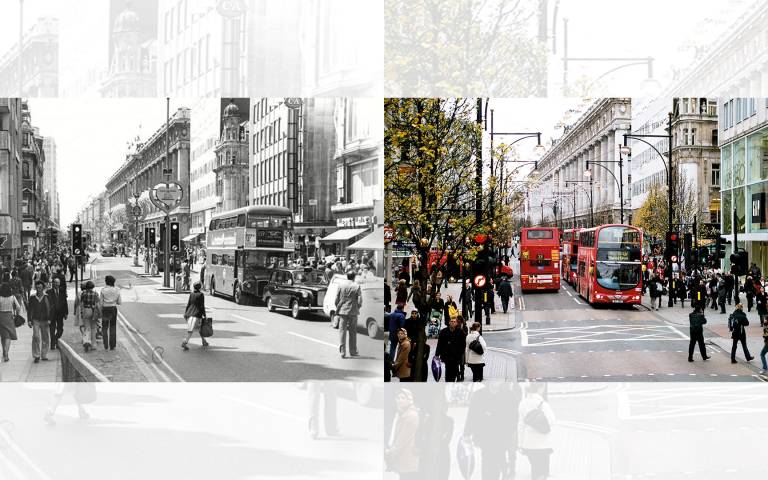 Research
Research

Subject
Mapping the Transition from the Pre-digital to the Digital City
First and second supervisors
Abstract
This thesis works on socio-historical change in Oxford Street, central London, during the transition from the post-war period to the contemporary city. This half-century period covers the full arc from the pre-digital to the contemporary city, where digital technologies have become pervasive in urban space. This is not simply about the rise of e-commerce. The impact of social media has embedded new potential in urban space to attract or repel movement flows and activities. However, providing a design-scale evidence-based for architects and urban designers to understand the impacts of this transition in this respect is not straightforward. This thesis is a contribution to this task.
The case study is Oxford Street, including a detailed study of two retail premises: Debenhams' London flagship store and Park House buildings. The research analyses socio-spatial patterns of them to highlight the details of the transformation from the pre-digital to the digital city at each of these scales in detail. It questions the proposition that social media is a new socio-spatial generator in urban centres. Instead, it proposes that social media reflect and emphasises Oxford Street's historical configuration of socio-spatial generators. It is concluded that architects and urban designers should balance the short-term impact of new digital technology with the longer-term effects of urban spatial configuration at different urban scales.
Biography
Farbod Afshar Bakeshloo is an architect and researcher. He studied Architecture BSc. at Shahid Beheshti University and Urban Design MSc. at the University of Tehran. Now, he is a PhD candidate at the Bartlett School of Architecture in the Space Syntax Laboratory. His PhD research is about the impacts of social media on the movement patterns and distribution of activities in space.
Farbod has a diverse experience in academia and professions. He has collaborated on several research projects in the UK, (at UCL) Iran (at Science and Technology Vice-Presidency and Shahid Beheshti University of Medical Sciences), and France (Centre de recherches historiques). Besides, he teaches at the Bartlett as a tutor in the Space Syntax workshop and as a senior teaching assistant in Architecture MArch (ARB/RIBA Part 2). Lastly, he is a columnist for Etemad and Shargh newspapers in Iran. He writes articles about crises in architecture and the city, like housing, pandemic, etc.
Links
- Publications
Academic:
- Bakeshloo, Afshar and Griffiths, Sam; (2022). A tale of "two streets" : changing land-uses and media contexts on Oxford Street, 1970 and 2019 compared. In: Annual Conference Proceedings of the XXVII International Seminar on Urban Form, pp. 146-153. https://tinyurl.com/3xe8u9km
- Bakeshloo, Afshar and Griffiths, Sam; (2022). Digital intervention in space: Does social media change the movement potential of Oxford Street? In: Conference Proceedings of the 13th International Space Syntax Symposium. (short paper) https://tinyurl.com/mmanzb8u
- Afshar Bakeshloo, F; (2021). A line with a history: using land-use data to plot change and continuity in Oxford Street between 1970 and 2019. in: Conference Proceedings of the 1st international online space syntax PhD conference pp. 93-94. https://tinyurl.com/2yhw2uvr and https://tinyurl.com/2hfy9ddp
Media:
- The Spatial logic of Covid-19 (2021)
- A simple formula (2021)
- The beginning of the end (2021)
- A Roof, Not A Home (2022)
- The Architect (2022)
- Why does the location of the protest matter? (2022)
- Architecture in Iran after "Woman, Life, Freedom" (2023)
- Revisiting Mohsen Habibi's theory: The evolution of Iranian city over time (2023, in collaboration with Babak Akbari)
- Between life and death in urban space (2023)
Image: Oxford Street in pre-digital (left) and digital (right) eras. Farbod Afshar Bakeshloo (2020) (Adapted from Wikipedia and Evening Standard)
 Close
Close

